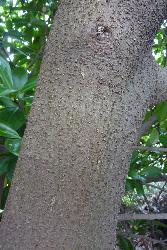- Taxon
- Gallery
Canopy tree up to ± 15 m. tall; trunk up to ± 6 dm. diam.; branches stout. Lvs on stout petioles c. 10–15 mm. long; lamina thick, coriac., elliptic- to obovate-oblong, (5)–10–15–(20) × (3)–5–7 cm., dark green, glossy; margins recurved. Fls 4–5 mm. diam., in stout stiff panicles up to c. 2 dm. long; peduncles and pedicels short. Sepals suborbicular; petals greenish yellow, ± 5 mm. long, minutely crenately toothed; obovate-spathulate; staminodes spathulate, minutely toothed; style c. 2 mm. long, thick; stigma capitate. Drupe 2.5–4 cm. long, ellipsoid to ovoid, orange; seed with distinct testa-veins; cots plano-convex, fleshy.
[From: Allan (1961) Flora of New Zealand. Volume 1.]
Flowering: Aug.–Nov.; Fruiting: Jan.–Apr.




